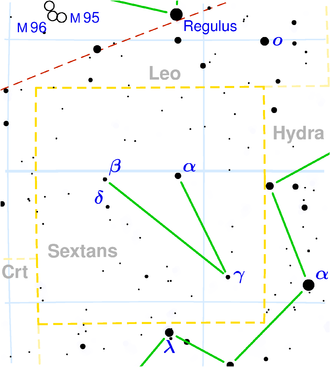NGC 3092
| Galaxy NGC 3092 |
|
|---|---|

|
|
| SDSS recording | |
| AladinLite | |
| Constellation | sextant |
|
Position equinox : J2000.0 , epoch : J2000.0 |
|
| Right ascension | 10 h 00 m 47.4 s |
| declination | -03 ° 00 ′ 45 ″ |
| Appearance | |
| Morphological type | SB (s) 0+? |
| Brightness (visual) | 13.5 likes |
| Brightness (B-band) | 14.4 mag |
| Angular expansion | 1.3 ′ × 0.6 ′ |
| Position angle | 30 ° |
| Surface brightness | 13.1 mag / arcmin² |
| Physical data | |
| Redshift | 0.019740 +/- 0.000023 |
| Radial velocity | 5918 +/- 7 km / s |
|
Stroke distance v rad / H 0 |
(257 ± 18) x 10 6 ly (78.9 ± 5.5) Mpc |
| history | |
| discovery | Albert Marth |
| Discovery date | January 22, 1865 |
| Catalog names | |
| NGC 3092 • PGC 28967 • CGCG 008-019 • MCG + 00-26-008 • 2MASX J10004745-0300448 • LEDA 28967 • LDCE 693 NED004 | |
NGC 3092 is a lenticular galaxy of the Hubble type S0 / a in the constellation Sextant south of the ecliptic . It is estimated to be 257 million light years away from the Milky Way and has a diameter of around 100,000 ly.
In the same area of the sky are the galaxies NGC 3086 , NGC 3090 , NGC 3093 , NGC 3101 , among others .
The object was discovered by Albert Marth on January 22nd, 1865 .
